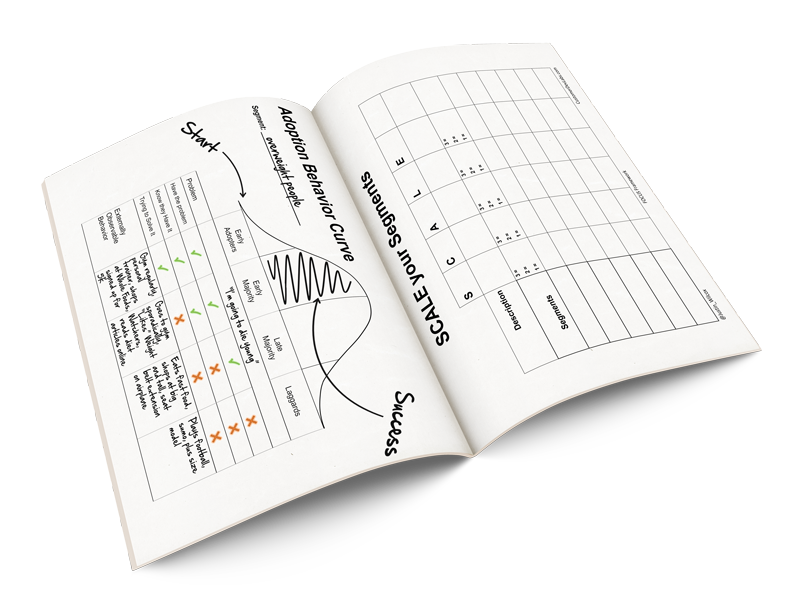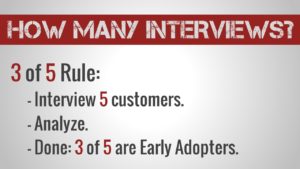One of the challenges of interviewing customers, is analyzing the results. I’m typically left with a pile of terse notes, and a handful of questions:
- What were the most common pains?
- If my assumption was invalidated, what do I do next?
- Were there any major themes that I missed?
My solution? Post-It Notes. Video walk-through below.
Example
The Lean Startup Conference recently asked me to run a workshop on the Science of Pricing. As I started to write the workshop’s description I realized I knew what I wanted to teach, but had no clue what entrepreneurs wanted to learn.
So I got out of the building and I interviewed a handful of founders about the difficulties they had pricing their products.
Here’s how I use Post Its to organize the mess of interview results:
Step 1: Find the Nuggets
The first thing I do is go through my notes and bold the salient points.
Step 2: Create One Post It per Nugget
Then I write up an (online) Post It note for each of the nuggets in one of my interviews.
Step 3: Repeat, with a Different Color
Then I repeat the process for another interview using different colored Post Its (you’ll see why later). This is why I use electronic Post Its – I don’t have enough real-life Post It note colors.
Step 4: Group Notes as you Go
As I create the Post Its, I group common themes together.
Step 5: Keep Only Groups of Post Its
Once I’m finished creating the Post Its, I usually have quite a mess. To clean that up, I get rid of any Post It that was only mentioned by one customer and keep everything that was mentioned twice+.
Step 6: Sort by Popularity
Next I prioritize the groups of Post Its based on how many customers mentioned those concepts. This is where the different colored Post Its come in handy.
Step 7: Harvest your Learnings
Finally, I create a summary with the core concepts and screen shots of the Post Its. Now I have an easy to read report of the findings, in order of importance, complete with real customer quotes!
This is the shit. If you create one of these, whenever you have a question about what problem you’re solving, “features” you should add to solve it, order to do things in, etc., you can turn to this report and instantly recall your customer’s needs. Bonus: you can easily share it with team members, advisers and potential investors.
For me, all that was left, was to combine what I learned into a description.
What’s Next?
Want help understanding your interviews? Schedule a 1-on-1 mentoring call.
This is Part 5 of our series of on Interviewing Customers:
- Which Customers Should you Interview (The SPA Treatment)
- How to Find Customers to Interview
- Getting Customer Interviews with Cold Emails
- How I Interview Customers
- You’ve Interviewed Customers. Now what?













What’s the best way to recruit currency testers? We’ve essentially been combining problem and solution interviews — asking about problems, doing a little demo, asking if that would solve anything, and then wondering why no one leaps at our discount and free trial offers. THANK YOU FOR THIS BLOG!
So, still learning your ways, but is the idea that you reach out to the folks you’ve problem-interviewed and say, hey, check out my product’s landing page, and see what happens?
And if no one comes… then you haven’t nailed your problem interviews?
Great insights Marin – you’re definitely on the right track.
You get currency testers from the people who converted from your “Offer Tests.” Ideally you reach out to both people you’ve interviewed, and more importantly, those you haven’t, seeing if they will engage with your Offer (proposed solution) by asking for more information (either by clicking a link you send, reading your landing page, submitting their email address, setting up a meeting, etc.).
Once you have that group of people, or a channel to more people like them, you start asking for currency from them to solve the problem.
Justin
Very nice thank you. Especially love how purposeful your interview questions are.
Hey Justin,
Awesome post! What app are you using for your post-it notes?
Thanks!
Hey Pete, I used http://linoit.com/.
Have fun!
Justin
Thanks so much Justin. I’m loving Linoit!!! Clever, clever. Just what I needed to structure a gazillion customer inputs!
Thanks Justin. You’re always super helpful :)
How do you suggest organizing and summarizing the results of 20+ interviews? What you showed above seems to work for 4 interviews (or however many post-it colors you have).
Thanks!!
Great question Alex. What would happen if you did the above with 5 of your interviews, and then repeated the process again with the next 5?
Would the second batch of 5 easily fall into the same “clouds” as the first 5, or do you think they’d generate a different set of post-it clouds?
If it’s the former, I’d keep doing the process in chunks and see what comes out. If it’s the latter, it’s possible you’re interviewing customers across customer segments and may not find a pattern among the noise because they all have different problems. If that’s the case, I might narrow my focus on one subset of those customers whose problem I was most interested in solving and interview more of them.
Make sense?
hey Justin,
I was left with this question after doing about two rounds of interviews (~40 total) . I had found several problems, but which would I solve? I had qualitative, but not quantitative data. So I’m surveying people now to get lots of data, then will add up responses to indicate which problem(s) are higher priority.
The above may be useful for seeing what came out qualitatively, but assuming it’s from just a few dozen interviews, it’s too little quantitative research. Perhaps your interviewees aren’t representative and the data is skewed…?
So I think the above is a great way to make sense of your interview data (qualitative data), and you may want to elaborate and say that there’s a need for quantitative to rank problems as the next step. What do you think?
BTW, really loving the blog ! Keep on sharing the goods :D.
Sorry I didn’t reply to this earlier Gab, but thanks for the great question.
I think the need to follow-up with quantitative data is important…if it validates your riskiest assumption. Typically after I’ve done my interviews I like to validate my results by running a “currency test.” In other words, will people give me something valuable to solve the problem I’ve identified during the interviews.
This test is a form of quantitative research that answers a question that’s more interesting that something like “X% of survey respondents indicated _______.”
So yes, after qualitative data comes quantitative…as long as we’re quantifying something awesome.
Hi Justin,
After conducting the customer problem discovery interviews, how do you suggest we go about “currency testing”?
The approach I’m thinking is something like this: After interviewing customers/early adopters about their problem and that my problem hypothesis is validated, can I continue on by “describing” my solution and continue on to “currency test” to validate if my solution is something they find valuable? If I do currency test, what specific currency should I ask for? (ie. their email, pre-ordering of my solution, sign-ups)?
Would greatly appreciate your insights. Thanks!